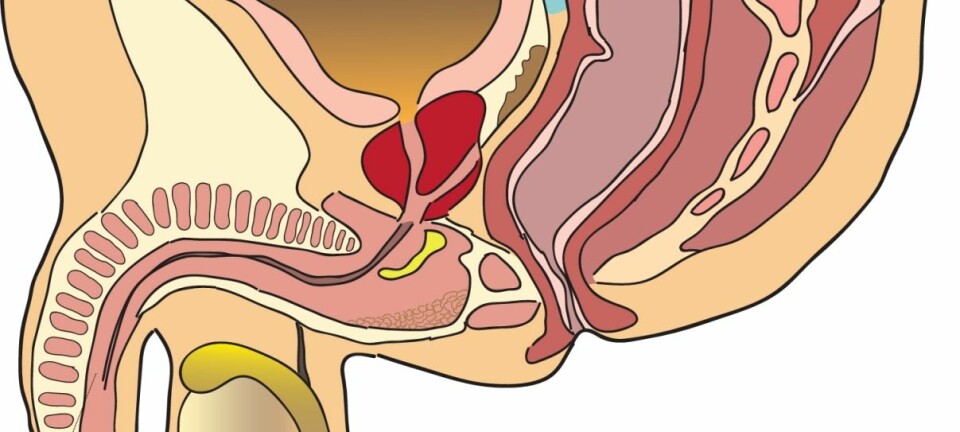
Endocrine disruptors cause a man's anus to crawl towards his penis
Men who were exposed to endocrine disruptors in their mother’s womb produce less male hormone and their sperm quality is poor, shows new research.
Over the past few decades scientists have observed a peculiar trend in men: their anogenital distance, which is the distance between their anus and penis, has shortened.
It’s a tell-tale sign that the men have become more effeminate -- most likely from a disruption in their hormone levels.
Scientists are now quite certain that the cause is to be found in the countless endocrine disruptors that surround us in most everyday objects like plastics, furniture, clothing, and packaging.
At the conference 'Endocrine disruptive substances -- status and trends' held at Copenhagen University Hospital and Rigshospitalet, Danish scientists presented their most recent findings.
“It would appear that certain phthalates are interconnected with a shorter anogenital distance,” says Anna-Maria Andersson, head of research at the the Department for Growth and Reproduction at Copenhagen University Hospital, Rigshospitalet. “There are signs that mothers who are most exposed to these phthalates also face a greater risk of giving birth to boys with a shorter anogenital distance.”
By measuring the anogenital distance of a person or animal it is possible to determine how much testosterone it was exposed to during pregnancy.
Men have lower testosterone levels
Changes in the anogenital distance are not the only sign that men have more effeminate bodies.
“There is a correlation between a shorter anogenital distance in a boy and his testicles not having dropped into the scrotum. At the same time, the shorter distance results in poorer sperm quality,” says Andersson.
In 2012 a survey at the Department for Growth and Reproduction at Copenhagen University Hospital, Rigshospitalet showed that the sperm quality of young men joining the army had fallen significantly. Only 23 per cent of the young men had optimal sperm quality.
"At the same time there has also been a fall in men's testosterone levels," says Professor Niels Erik Skakkebæk of the Department for Growth and Reproduction at Rigshospitalet.
When boys are born without the ability to produce enough male hormones -- especially testosterone -- they can't enter puberty. That means they have to be given a testosterone treatment.
“A lot of men are asking for testosterone, both in the US and Denmark. Three major studies involving thousands of men in the US, Denmark and Finland have shown the same: testosterone levels have fallen between the 1980s and the present day,” says Skakkebæk.
“We're not certain why. Obesity may be one explanation,” he says. “At the same time, however, it looks as though there is a trend as far as genital abnormalities are concerned. And I think these trends are linked.”
Cocktail of substances produce penis cleavage
Experimenting with endocrine disruptors on humans is difficult because it would involve impairing people's lives already from the embryo stage.
However, experiments on rats leave no doubt as to what phthalates and other endocrine disruptors can wreak in the form of havoc on the male genitals
The different substances become especially dangerous when they are mixed -- scientists call it interactions.
One such interaction was done by Professor Ulla Hass from the Department of Foodstuffs at Denmark's Technical University. She tested 13 different endocrine disruptors on rats. Separately, they didn't wreak much havoc -- but when mixed together the results were horrifying.
"We observed numerous interactions. The rats' anogenital distance shortened, they developed nipples, and their penises showed abnormalities,” says Hass.
The rats developed a cleavage of the penis, in which the penile bone, or penis, was not enclosed by tissue. Some 60 per cent of the baby males had this problem.
The problem with interactions is that it makes it difficult for scientists to inform the authorities as to precisely which substances should be banned.
"If you keep putting drops into a beaker it will ultimately overflow. It's difficult to say which drop it was that caused the beaker to overflow," says Hass.
UV filters in sun tan lotion confuse sperm cells
Recent studies also suggest that a combination of endocrine disruptors have a powerful effect on the behaviour of sperm cells.
So says PhD student Anders Rehfeld from the Department for Growth and Reproduction at Rigshospitalet. He has discovered that 33 chemicals out of 100 he tested can each trigger unfortunate reactions in sperm cells.
Normally, sperm cells swim along happily until they reach the woman's egg. When they reach the egg they come across the substance Ca2+ which makes sperm cells thrash their tails so that they can force their way into the egg and fertilise it.
It turned out that the 33 artificial substances had the same effect on sperm cells as Ca2+. So if the endocrine disruptors get into a man's semen, the sperm cells start thrashing their tails far too early in their process.
As a result they charge about in manic circles and are exhausted well before they can reach an egg.
Rehfeld then tested to see if ten of the substances produced an interaction. On their own, they didn't have much effect on the sperm cells but when tested all at once the effect was significant.
"And that was just 10 substances,” says Rehfeld. “We found 33 harmful substances among the 100 we tested and it's quite possible the reaction of sperm cells will be even more pronounced if they are exposed to all 33.”
His study shows that the unfortunate effect on sperm cells came especially from UV filters in sun tan lotions and on clothing.
UV filters have previously been found in men who had applied sun tan lotion immediately preceding testing. Rehfeld now intends to find out whether the substances are also found in women.
If so, men with otherwise healthy semen risk their sperm cells going bananas as soon as they meet the chemicals inside a woman.
--------
Read the original story in Danish on Videnskab.dk
Translated by: Hugh Matthews









